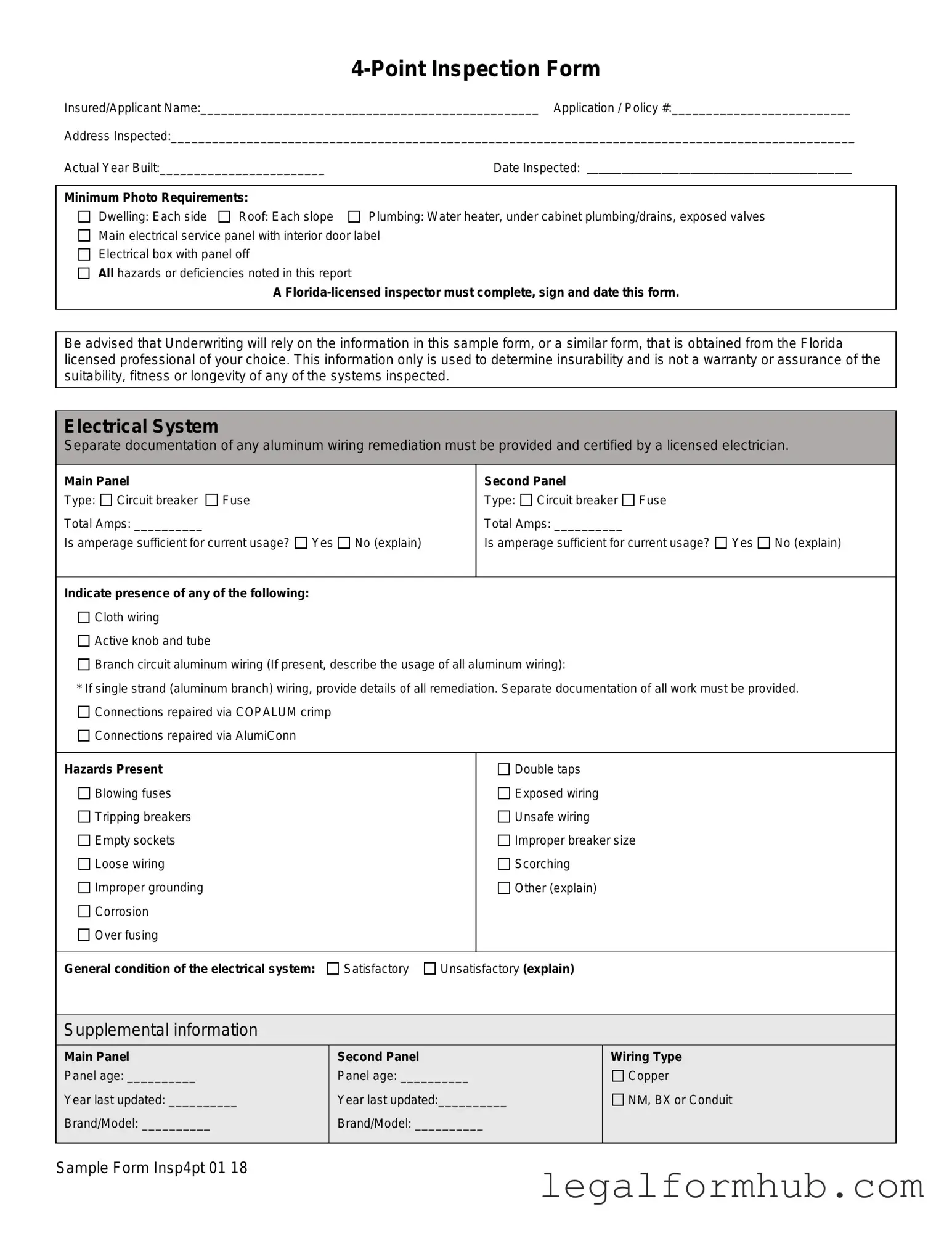The Home Inspection Report serves a similar purpose to the 4-Point Inspection Form, focusing on the overall condition of a property. It typically covers various systems, including plumbing, electrical, HVAC, and structural elements. Like the 4-Point Inspection, a licensed inspector conducts the evaluation and documents any visible issues. However, the Home Inspection Report is more comprehensive, often providing a detailed narrative of the property's condition, including recommendations for repairs and maintenance. This document is crucial for buyers and sellers in real estate transactions, as it helps them understand the property's value and potential issues that may need addressing.
The Arizona Motor Vehicle Bill of Sale form is a crucial document in the vehicle transaction process, ensuring that all details regarding the transfer of ownership are clearly outlined and legally recognized. This document not only protects the seller by offering proof of the sale but also safeguards the buyer by detailing the vehicle's condition and any agreed-upon terms. For more information about this important form, you can visit https://arizonapdfs.com/motor-vehicle-bill-of-sale-template/.
The Roof Inspection Report specifically targets the condition of the roofing system. Similar to the 4-Point Inspection, it requires a licensed inspector to assess the roof's materials, age, and overall condition. This report focuses on identifying visible signs of damage, such as leaks, missing shingles, or deterioration. While the 4-Point Inspection includes a roof assessment as part of a broader evaluation, the Roof Inspection Report provides a more detailed analysis, often including recommendations for repairs or replacement, which can be vital for homeowners or potential buyers.
The Electrical Inspection Report is another document akin to the 4-Point Inspection Form, concentrating solely on the electrical systems within a property. This report examines wiring, circuit breakers, and the overall safety of the electrical setup. Like the 4-Point Inspection, it aims to identify hazards and deficiencies, ensuring that the electrical system meets safety standards. However, the Electrical Inspection Report goes deeper into specifics, often including load calculations and recommendations for upgrades or repairs, which are essential for ensuring the safety and functionality of a home’s electrical system.
The Plumbing Inspection Report shares similarities with the 4-Point Inspection Form by evaluating the plumbing systems in a home. It assesses water supply lines, drainage systems, and fixtures for any signs of leaks or damage. While the 4-Point Inspection gives a general overview, the Plumbing Inspection Report offers a more detailed analysis, often including information about pipe materials and age, which can be crucial for homeowners looking to address plumbing issues proactively. This document is particularly important for identifying potential problems before they escalate into costly repairs.
The HVAC Inspection Report focuses specifically on heating, ventilation, and air conditioning systems, paralleling the HVAC section of the 4-Point Inspection. It evaluates the operational efficiency and safety of these systems, documenting any issues that could affect performance. This report often includes details about the age of the system, maintenance history, and recommendations for repairs or replacements. While the 4-Point Inspection provides a snapshot of HVAC conditions, the HVAC Inspection Report delves deeper, offering insights that can help homeowners ensure their systems are functioning optimally.
The Insurance Underwriting Inspection Report is closely related to the 4-Point Inspection Form, as it provides necessary information for insurance underwriting purposes. This document assesses the condition of key systems in a property to determine insurability. It includes details on the roof, electrical, plumbing, and HVAC systems, similar to the 4-Point Inspection. However, the Insurance Underwriting Inspection Report is often more focused on risk assessment for insurance purposes, emphasizing any hazards or deficiencies that could affect coverage and premiums.
The Seller's Disclosure Statement, while not an inspection report, shares some similarities with the 4-Point Inspection Form in that it provides information about the condition of a property. This document is typically filled out by the seller and outlines known issues, repairs, and maintenance history. Like the 4-Point Inspection, it aims to inform potential buyers about the property's condition. However, the Seller's Disclosure is based on the seller's knowledge rather than an independent inspection, which can lead to discrepancies in the information provided.
The Maintenance Inspection Report is similar to the 4-Point Inspection in that it evaluates the condition of various systems within a property. This report is often used by homeowners to identify maintenance needs and ensure that systems are functioning correctly. While the 4-Point Inspection is typically required for insurance purposes, the Maintenance Inspection Report is more proactive, focusing on ongoing upkeep rather than compliance. It helps homeowners prioritize repairs and maintenance to prolong the life of their systems.
The Property Condition Assessment (PCA) is another document that resembles the 4-Point Inspection Form. It provides a comprehensive overview of a property's condition, including structural, mechanical, and electrical systems. The PCA is often used in commercial real estate transactions and includes a detailed analysis of the property's physical condition. While the 4-Point Inspection is more focused on residential properties and specific systems, the PCA offers a broader assessment, making it useful for investors and property managers looking to understand the overall health of a property.
